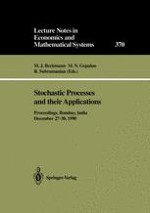A volume of this nature containing a collection of papers has been brought out to honour a gentleman - a friend and a colleague - whose work has, to a large extent, advanced and popularized the use of stochastic point processes. Professor Srinivasan celebrated his sixt~ first 1:!irth d~ on December 16,1990 and will be retiring as Professor of Applied Mathematics from the Indian Institute of Technolo~, Madras on June 30,1991. In view of his outstanding contributions to the theor~ and applications of stochastic processes over a time span of thirt~ ~ears, it seemed appropriate not to let his birth d~ and retirement pass unnoticed. A s~posium in his honour and the publication of the proceedings appeared to us to be the most natural and sui table ~ to mark the occasion. The Indian Societ~ for ProbabU it~ and Statistics volunteered to organize the S~posium as part of their XII Annual conference in Bomba~. We requested a number of long-time friends, colleagues and former students of Professor Srinivasan to contribute a paper preferabl~ in the area of stochastic processes and their applications. The positive response and the enthusiastic cooperation of these distinguished scientists have resulted in the present collection. The contributions to this volume are divided into four parts: Stochastic Theor~ (2 articles), P~sics (6 articles), Biolo~ (4 articles) and Operations Research (12 articles). In addition the ke~note address delivered b~ Professor Srinivasan in the S~posium is also included.
